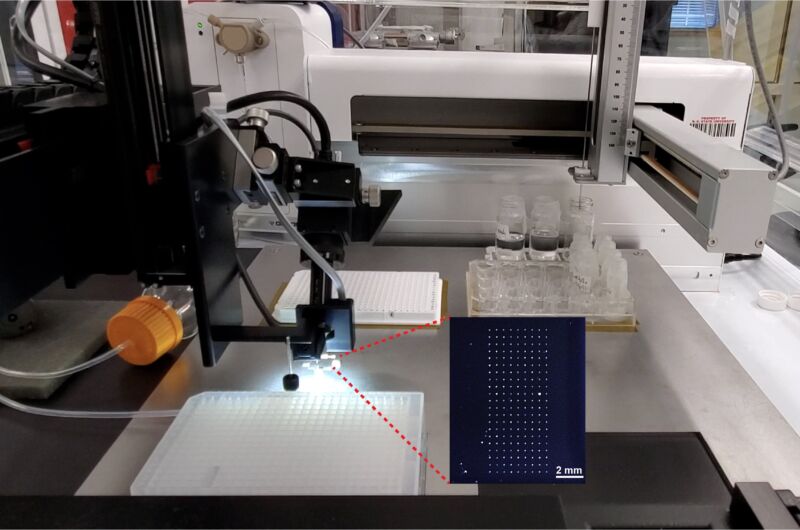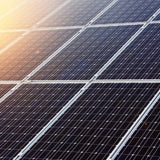
Earlier this year, two-layer solar cells broke records with 33 percent efficiency. The cells are made of a combination of silicon and a material called a perovskite. However, these tandem solar cells are still far from the theoretical limit of around 45 percent efficiency, and they degrade quickly under sun exposure, making their usefulness limited.
The process of improving tandem solar cells involves the search for the perfect materials to layer on top of each other, with each capturing some of the sunlight the other is missing. One potential material for this is perovskites, which are defined by their peculiar rhombus-in-a-cube crystal structure. This structure can be adopted by many chemicals in a variety of proportions. To make a good candidate for tandem solar cells, the combination of chemicals needs to have the right bandgap—the property responsible for absorbing the right part of the sun’s spectrum—be stable at normal temperatures, and, most challengingly, not degrade under illumination.
The number of possible perovskite materials is vast, and predicting the properties that a given chemical composition will have is very difficult. Trying all the possibilities out in the lab is prohibitively costly and time-consuming. To accelerate the search for the ideal perovskite, researchers at North Carolina State University decided to enlist the help of robots.
Automating chemical searches
“We deal with material variants every single time we make an improvement on this technology,” said Aram Amassian, professor at NCSU and principal investigator on the project. “So we need the ability to create new materials and evaluate these materials. Any person looking at these materials has to do repetitive, very labor-intensive work.”
To cut down on this work, Amassian’s team built a robot, lovingly named RoboMapper. The RoboMapper consists of two main parts working together. The first is the ink-preparation bot. Given a set of base chemicals, this bot combines them in different proportions and formulates them into hundreds of inks that can potentially form perovskites. The second is the printing bot, which applies these inks in a grid onto a single substrate.
The ability to position hundreds of tiny samples on a single chip, a task impossible with human-level dexterity, enables researchers to test all these samples simultaneously using various diagnostic tools. The researchers say this speeds up the synthesis and characterization of materials by a factor of 14 compared to manual exploration and by a factor of nine compared to other automated methods.
To show off the capabilities of RoboMapper, the researchers tested a specific set of potential perovskite mixtures. They used the RoboMapper to mix three basic ingredients in hundreds of different proportions and print all the samples onto a single chip. They then tested these samples to determine their structure, bandgap, and stability under light exposure. From these accelerated tests, they constructed quantitative models relating how these critical properties vary to the changing composition. “We're able to build predictive models and look at areas between the data points,” Amassian said. “Sometimes the better compositions might be in unexpected regions of the chemical composition space.”
Using their RoboMapper workflow, the research team successfully identified an "ideal" perovskite mixture that exhibited the desired properties for use in tandem solar cells. This sample had the right bandgap and also degraded slowly under light exposure compared to alternatives.
Work in progress
This discovery represents a preliminary step in the journey toward advancing tandem solar cell technology. Amassian’s team only tested the perovskite itself and did not combine it with silicon (or any other substrate) to create tandem cells. But the researchers are using their accelerated tool to test other potential mixtures and are rapidly finding promising new candidates.
Using the RoboMapper not only saves researchers time but also lowers the energy cost of testing new materials. In fact, with this technology, testing one material may cost less energy than it would take to simulate its properties using computers. This will allow researchers to generate significantly more real-world data for direct use or to bootstrap machine learning techniques. “To train, for example, machine learning and AI models, we need more data,” Amassian said. “We need higher-quality data. And we need to explore the high dimensional space efficiently.”
This approach is not limited to perovskites or solar cell applications—it’s already being used to enable data-driven semiconductor research. “When we designed the RoboMapper, we designed it to be very flexible and modular and expandable,” Amassian said. Any searches for materials that can be manufactured using an inking technique could be accelerated with this technology, including printed electronics, because the RoboMapper is first and foremost a robot that formulates and prints inkable materials on demand.
Matter, 2023. DOI: 10.1016/j.matt.2023.06.040
Dina Genkina is a freelance science writer and podcaster based in Brooklyn and a science communicator at the Joint Quantum Institute. She's interested in quantum physics, AI, climate tech, and other cool things.



3175x175(CURRENT).thumb.jpg.b05acc060982b36f5891ba728e6d953c.jpg)

Recommended Comments
There are no comments to display.
Join the conversation
You can post now and register later. If you have an account, sign in now to post with your account.
Note: Your post will require moderator approval before it will be visible.